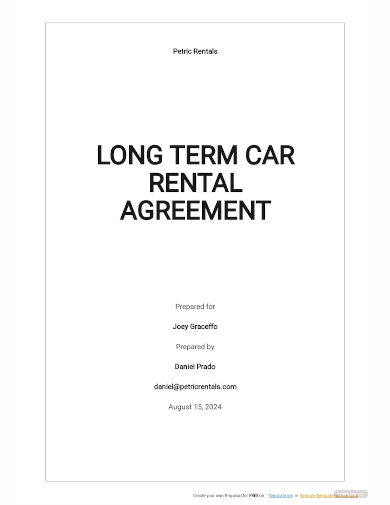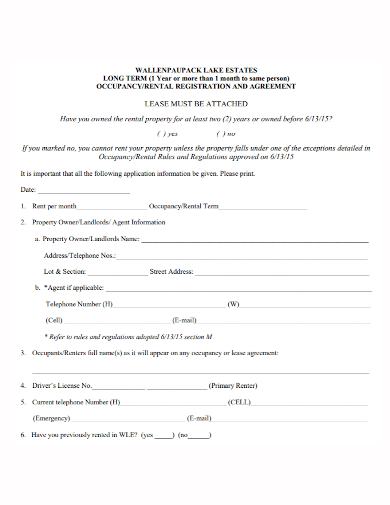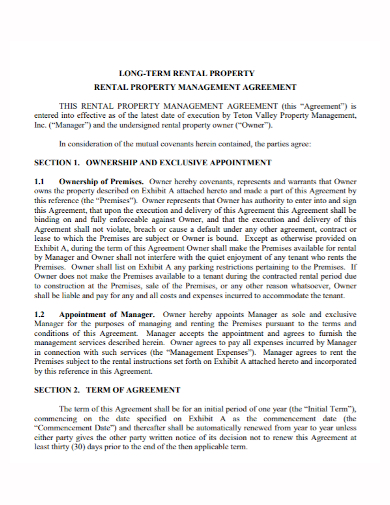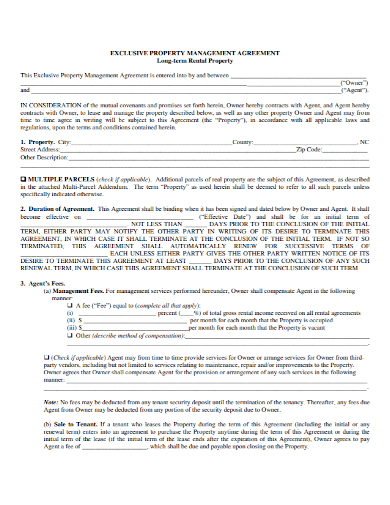If you’re a landlord with multiple properties, you may want to rent it to potential tenants to earn some income. Some landlords prefer to have a long-term rental because of its routine and stable income. If you’re interested to enter a long-term rental business with your tenants, you need an agreement to seal the deal and protect your business and at the same time protect your tenants. Read the article to find out how to create a long-term rental agreement.
5+ Long Term Rental Agreement Samples
1. Long Term Rental Agreement Template

2. Long Term Car Rental Agreement Template

3. Long Term Rental Registration Agreement
4. Long Term Rental Property Agreement
5. Long Term Rental Management Agreement
6. Sample Long Term Rental Agreement
What is a Long Term Rental Agreement?
A lease agreement or a long-term rental agreement is a contract between a landlord and a tenant that covers the renting of property for long periods, usually 12 months or more. It lists down all the responsibilities that both parties have to do during the lease and it includes all necessary information to make sure that both parties are legally protected.
Details to Include in a Long Term Rental Agreement
There are provisions every lease should have, no matter what format is used in the agreement. The agreement must contain at least these following provisions:
- Description: Describe the top part of your agreement of what the agreement is about. You can title it as a “Lease Agreement,” or “Residential Lease Agreement.” Include the landlord’s and tenant’s names and the tenant’s current address and contact information, and your business address. Write the words landlord and tenant after your names.
- Property Description: Identify the property such as its street address and a description of the location.
- Term of Tenancy: This information describes the length of the lease and the date when the lease ends. Since this is a long-term rental, the lease can last at least six months to several years.
- Occupants‘ Names: Get the names of the people who will occupy the property. This will ensure that no other people can live and rent the property.
- Monthly Rent: Take note of the schedule of the due date of the rent where the tenant pays the rent every month.
- Security Deposit: List down the amount of security deposit that the tenant gave you.
- Extra Clauses: State if the property is furnished or not, and if the tenant gets a parking space or not. State if you will include the utilities in the monthly rent or if the tenant is the one who will pay for it themselves. State also if you allow pets in the property and if you do, mention if you charge extra for pets.
- Tenant’s Duties: State what the tenant can and cannot do inside the property. State also the responsibilities they are assigned to do such as being responsible enough to do maintenance of the property.
- Landlord’s Duties: State the duties you are responsible to do such as making repairs to the property and inspect the property itself.
- Grounds for Eviction or Tenant Breaks the Lease: State that the tenant should not engage in illegal activities should not make alterations or damage the apartment since these will be the grounds for eviction. If the tenant prematurely breaks the lease, explain how much you will charge. Make sure you know the laws about this and you followed them properly.
- Lease Renewal: State what will be your procedure for renewing the tenant’s lease of your property.
FAQs
What are the pros and cons of a long-term rental agreement?
Here are the pros and cons of having a long term rental agreement as your business:
Pros:
- Stable income: Many landlords like the long-term tenancy agreement because of the steady income.
- Less time and effort: Long-term tenancy agreements create a routine for landlords to collect money during its set due date making it easier to monitor payments.
Cons:
- Lack of flexibility: Even though they offer stable income, you cannot take advantage of increasing rental prices in your area to your tenants.
- Legal obligations: There are additional legal obligations for long-term tenancy agreements that landlords need to abide by; sometimes it can be tiring for landlords but this is part of their responsibility to keep their tenants safe in their property.
What are the different types of leases?
There are a lot of different types of leases that exist. Those are equitable leases, fixed-term leases, periodic leases, tenancy at will, and tenancy at sufferance.
What makes a lease invalid?
A lease can be automatically void when the lease is used for illegal purposes.
Conclude your agreement contract by putting your signature and your tenant’s. Don’t forget to list the words landlord and tenant under the signature lines. Include the date of when you signed the lease. Make sure that the agreement is written in clear and understandable language. To help you get started on making the rental agreement, download our free sample templates above to use as your reference!
Related Posts
Sample Business Agreement between Two Parties
FREE 10+ Trial Agreement Samples In MS Word | Google Docs | Apple Pages | PDF
FREE 9+ Shop Rental Agreement Samples [ Commercial, Lease, Tenancy ]
FREE 10+ Charter Agreement Samples In MS Word | Google Docs | Apple Pages | PDF
FREE 10+ Mentoring Agreement Samples In MS Word | Apple Pages | PDF
FREE 10+ Partner Agreement Samples In MS Word | Google Docs | Apple Pages | PDF
FREE 10+ Individual Agreement Samples In MS Word | Google Docs | Apple Pages | PDF
FREE 10+ Strategic Agreement Samples In MS Word | Google Docs | Apple Pages | PDF
FREE 10+ Equity Agreement Samples In MS Word | Google Docs | Apple Pages | PDF
FREE 10+ Producer Agreement Samples in MS Word | Apple Pages | PDF
FREE 10+ Grant Agreement Samples In MS Word | Apple Pages | PDF
FREE 8+ Meeting Agreement Samples in MS Word | Google Docs | Apple Pages | PDF
FREE 10+ Community Agreement Samples In MS Word | Google Docs | PDF
FREE 8+ Real Estate Option Agreement Samples in MS Word | PDF
FREE 10+ Call Option Agreement Samples In MS Word | PDF




